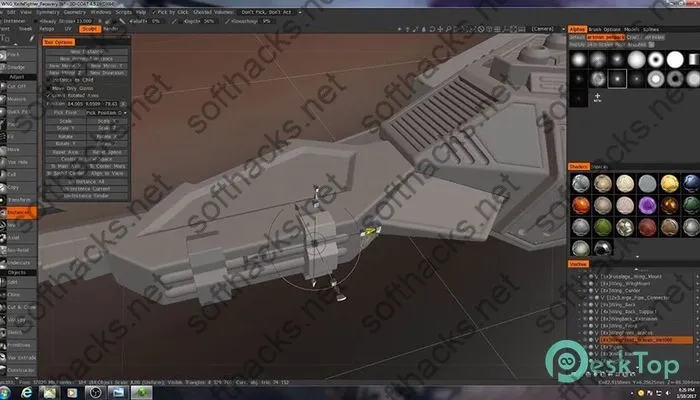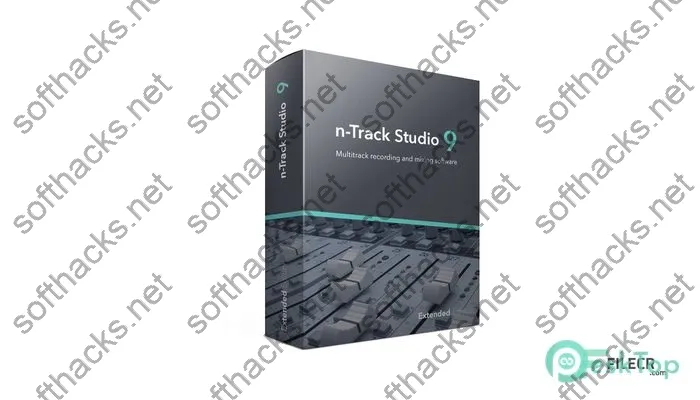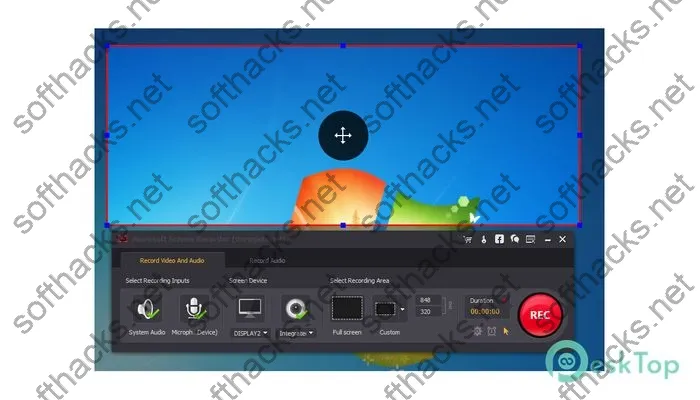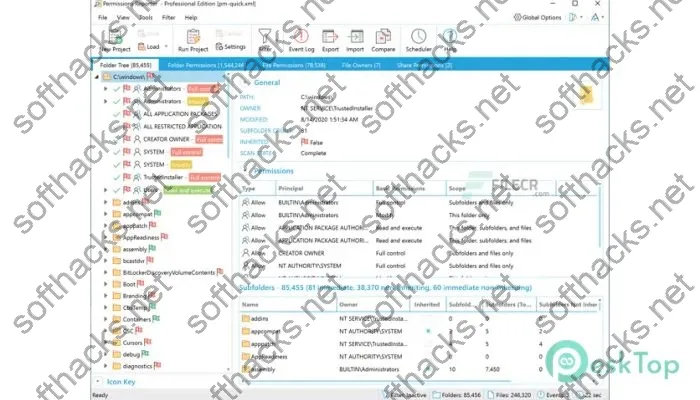3D Coat Keygen is a 3D painting program optimized for texture painting, digital sculpting, and voxel-based modeling. It was originally developed as a tool for painting textures on 3D models, but has expanded to become a full suite for concept art, game asset creation, and 3D printing prep.
Some of the standout features of 3D Coat Download free include:
- Intuitive voxel sculpting tools for organic and hard surface modeling
- Unique texture painting workflow with layers and blending modes
- Physically-based rendering (PBR) shaders and real-time render engine
- Support for all major 3D model formats like OBJ, FBX, STL, etc.
- Virtual reality support for Oculus Rift and HTC Vive
While not as widely-used as tools like Blender or ZBrush, 3D Coat excels in specific applications like detailed texture painting, dynamic topology sculpting, and voxel-based modeling. It’s optimized to be fast and responsive, making it popular for game developers working on 3D assets.
- Key Features of 3D Coat Keygen
- Use Cases for 3D Coat
- 3D Coat vs Other 3D Modeling Programs
- 3D Coat Keygen Interface Walkthrough
- Sculpting in 3D Coat
- Texturing and Painting
- Rendering in Free download 3D Coat
- 3D Coat Tutorials for Beginners
- Tips and Tricks in 3D Coat
- How to Improve Skills in 3D Coat
- FAQ – Common Questions About 3D Coat
- Conclusion
Key Features of 3D Coat Keygen
Voxel Sculpting
The voxel sculpting system is what really sets Free download 3D Coat apart. Unlike polygon modeling, voxels allow you to sculpt by directly manipulating volumetric pixels. This enables very fine detail and precision when doing organic sculpting and hard surface modeling.
3D Coat uses dynamic tessellation to adapt the mesh as you sculpt. You can sculpt at a high resolution with millions of voxels, then retopologize later for efficient game engines. The voxel system allows for very fast, flexible workflows.
Texture Painting Tools
As the name suggests, Full version crack 3D Coat Keygen first focused on 3D painting and texturing. It uses a layer-based workflow like Photoshop with popular features like masks, blending modes, and environment projection mapping.
The real-time feedback while painting directly on a 3D model sets 3D Coat apart. Artists can create detailed texture maps and materials without needing to jump between programs.
PBR Rendering
3D Coat uses a physically-based rendering (PBR) shading system to accurately preview materials and lighting. This allows materials painted in 3D Coat to be exported with their shaders and seamlessly used in game engines like Unity or Unreal.
Advanced material editing is also possible using nodes for effects like transparency, glows, and reflection. Multiple render passes can combine to create the final rendered image.
Model Format Support
3D Coat supports all major 3D model formats for import and export. This includes OBJ, FBX, STL, PLY, 3DS, Collada DAE, STEP, IGES, and more.
You can bring in models from other programs like Maya, Blender, and ZBrush for texturing and refinement in 3D Coat. And easily export back out when complete.
Use Cases for 3D Coat
Concept Art and Digital Sculpting
Many concept artists use 3D Coat for quickly blocking out 3D models based on sketches or painting over models for illustrations. The dynamic topology sculpting is great for getting ideas modelled out in 3D.
It can also be used to generate normal, ambient occlusion, and curvature maps from high poly sculpts for texturing. And painting over models to visualize materials and lighting.
Video Game Asset Creation
3D Coat is popular in the gaming industry for quickly creating optimized 3D assets. The voxel modeling allows sculpting highpoly models with all details, which can then be retopologized and UV unwrapped for game engines.
The texture painting tools make painting complex PBR shader materials faster than baking from high poly models. The ability to natively import and export from game engines is a big plus.
3D Printing Models
Voxel sculpting lets you easily create highly detailed 3D sculpts perfect for 3D printing. Models can be analyzed for printability and output with the necessary thicknesses and structural support.
Retopology tools make it easy to reduce poly counts from millions to thousands while still retaining details. The voxel approach prevents messy booleans common with polygon meshes.
Texture Painting
As a dedicated texture painting program, artists can paint highly detailed textures in 3D Coat with unique tools likeprojection painting, microvertex painting, and texture cloning.
The real-time feedback when painting on a model is faster than baking maps. And textures made with PBR shaders can move seamlessly into rendering.
3D Coat vs Other 3D Modeling Programs
How does 3D Coat compare to other popular digital sculpting and 3D modeling programs? Here’s a quick rundown of the pros and cons versus some alternatives:
Compared to ZBrush:
- ZBrush is more fully-featured for organic characters and creatures. 3D Coat excels more at hard surface modeling.
- ZBrush uses polygons rather than voxels, which can cause lag at high sculpt levels.
- 3D Coat has better tools for retopology and UV unwrapping.
- ZBrush is the industry standard for digital sculpting. 3D Coat is less common.
Compared to Blender:
- Blender is completely free and open-source. 3D Coat is paid software.
- 3D Coat is faster and more responsive when sculpting.
- Blender can handle animation and rigging whereas 3D Coat focuses just on modeling.
- Blender has more learning resources as the most popular free 3D software.
Compared to Maya:
- Maya is better for complex scene assembly with lots of models and precise modeling.
- 3D Coat specializes in organic sculpting and painting.
- Maya is the industry standard for 3D animation and VFX.
- 3D Coat is easier to pick up for beginners.
Compared to 3ds Max:
- 3ds Max has deeper CAD-style modeling tools.
- 3D Coat is preferred for freeform sculpting.
- 3ds Max connects tightly with rendering engines like V-Ray.
- 3D Coat aims to be self-contained for modeling, painting, and rendering.
Pros of 3D Coat
- Extremely responsive sculpting and painting even at high resolutions
- Great toolkit for hard surface modeling
- Powerful UV mapping and unwrapping tools
- Streamlined for efficiency focused on modeling and texturing
- Built to take advantage of modern GPU processing power
Cons of 3D Coat
- High learning curve compared to beginner tools like Blender
- Not as flexible for animation, rigging, simulation compared to Maya
- More limited learning resources and documentation available
- Must export to other programs for more advanced rendering
3D Coat Keygen Interface Walkthrough
When you first open 3D Coat, you may be overwhelmed by the interface. It’s quite different from other 3D software. Here’s a quick run through of the various menus and how the core workflow functions:
The Tools menu runs down the right side and contains all the sculpting, painting, and viewing tools. These are organized into sections like Sculpt, Slice, Transform, and Render.
At the top left are menus to open and manage Projects which contain all your models, textures, and materials. You can also import reference images here.
The Layers panel shows all the layers for the current model or texture. You can add, merge, clone, and convert layer types here.
The main viewport takes up most of the interface. You can split views and pivot the camera here. There are also handy view options like wireframe mode.
In the bottom left are the model Statistics which track poly count, texture memory usage, and other details. Model tree shows objects and parts.
Finally the Shelf above the viewport provides fast access to brushes, materials, objects, and other tools to keep workflow efficient.
With this basic understanding of the interface, let’s look closer at the sculpting, texturing, and rendering workflows in 3D Coat.
Sculpting in 3D Coat
Sculpting makes use of 3D Coat’s voxel modeling system. Rather than manipulating polygons, you work with volumetric voxels. This allows for incredibly detailed sculpts at high resolutions.
Some things that help streamline sculpting:
- Symmetry modeling – mirror sculpting across X, Y or Z axes
- Dynamic tessellation – adds detail where you sculpt
- Detail projection – project from high detail model to low
- Retopology – reduce poly count while maintaining detail
3D Coat has a wide range of both organic and hard surface sculpting brushes. Common brushes include:
- Clay – adds or removes material
- Smooth – relaxes details and reduces noise
- Move – pushes voxels around
- Inflate – expands surfaces evenly
- Twist – creates swirl patterns
- Pinch – pulls voxels into a point
Experience sculptors can achieve detail approaching millions of voxels or more. This raw detail can then be retopologized down to an optimal game model polygon count.
Texturing and Painting
While sculpting creates form, texturing adds realism through materials and colors. 3D Coat provides a full suite of painting tools tailored for 3D.
The workflow involves:
- Start with a physically-based rendering (PBR) template shader
- Paint color, roughness, metalness, normals maps
- Adjust shaders with nodes for effects
- Bake out textures maps as needed
Key painting features include:
- Paint directly on 3D model in real-time
- Use reference images and projection painting
- layers for blending and masks
- Mix paints on virtual palette
- Clone and reuse textures
- Custom brush shapes
The real-time feedback while painting on the 3D model directly makes texturing very intuitive. You immediately see the results on the model rendered with lighting.
Rendering in Free download 3D Coat
3D Coat Keygen has its own built-in rendering engine. This allows you to render models real-time while working and get a final render when complete.
Some key features of the renderer:
- Physically-based rendering – realistic lighting and materials
- Real-time rendering viewport
- Support for render passes – ambient occlusion, normals etc
- Camera effects like bloom, depth of field
- Light types like directional, point, and area
The real-time render view allows you to set up lighting and rendered the model interactively. Multiple render passes can be combined for the final result.
3D Coat’s rendering capabilities are suitable for basic rendering of models. For advanced rendering with complex materials and effects, programs like Blender’s Cycles renderer or KeyShot would be recommended.
3D Coat Tutorials for Beginners
The best way to start learning 3D Coat Full version crack is by following along with some beginner tutorials. This will introduce you to the basics of navigation, sculpting, and texture painting in 3D Coat.
We’ll take a look at some tutorial projects for complete beginners:
Creature Sculpting Tutorial
This sculpting tutorial walks through how to block out and detail a creature model. Along the way you’ll learn:
- Setting up reference images for guidance
- Using dynamic tessellation to add detail
- Refining forms with sculpting brushes
- Mirroring for symmetry
- Re-topologizing the final model
Following this creature sculpting tutorial will teach the foundations of bringing an idea to life in 3D.
Hard Surface Modeling Tutorial
For this project you’ll model a mechanical object like a sci-fi gun or robot part. Key concepts include:
- Starting from primitive shapes
- Using reference for proportions
- Refining forms with brushes
- Cutting into surfaces with slice brushes
- Optimizing topology flow
This is a great introduction to 3D Coat’s hard surface modeling capabilities.
Organic Sculpting Tutorial
This sculpting tutorial teaches how to approach more organic subjects like a human bust or full figure. You will learn:
- Blocking in major forms
- Using an anatomical reference
- Laying in primary and secondary forms
- Brushstroke patterns for organic look
- Best process for heads and bodies
Practicing organic sculpting will build foundational skills that apply to any organic subject matter.
Tips and Tricks in 3D Coat
Here are some professional tips and shortcuts to step up your 3D Coat workflow:
- Use Dyntopo sculpting for posing before refining forms
- Mix custom brushes to refine edges and surfaces
- Use Polygroups to manage and subdivide sections
- Clone textures between model parts for consistency
- Use cavity masking for auto-shadows in crevices
- Append multiple models to retopologize as one
- ZRemesher for automatic retopology
Learning hotkeys for common actions like hiding mesh parts or mirroring will speed up your workflow considerably. Take advantage of all the tools 3D Coat offers for efficient game asset creation.
How to Improve Skills in 3D Coat
Here are some tips on quickly improving your skills as a 3D artist within 3D Coat:
-
Use reference – Use real-world reference images to achieve accurate and realistic forms.
-
Practice fundamentals – Focus on mastering core skills like anatomy, perspective, and composition before tackling complex projects.
-
Follow tutorials – Work through sculpting and texturing tutorials to expand your toolset. Try mimicking techniques.
-
Analyze other artwork – Study 3D art that inspires you. Think about the techniques used and how to apply them to your work.
-
Refine over time – Don’t rush to finish a piece. Refine models over multiple passes to achieve quality results.
-
Participate in communities – Join forums and groups to ask questions and learn from other experienced users.
Dedicating time each day to focused practice and pushing yourself outside your comfort zone will help accelerate your progress.
FAQ – Common Questions About 3D Coat
Is 3D Coat worth learning?
For certain applications like game asset texturing, hard surface modeling, and preparing 3D print models, 3D Coat absolutely excels and is worth learning. While not as common as tools like ZBrush, it can be a great addition for projects requiring voxel sculpting and 3D painting.
How does 3D Coat Keygen compare to ZBrush?
ZBrush is more fully-featured and the industry standard for organic sculpting of creatures and characters. 3D Coat specializes in voxel sculpting for hard surface models with clean topology. It also has excellent baking and texturing capabilities. Many artists use both depending on the project needs.
Can you animate in 3D Coat?
No, 3D Coat Keygen focuses solely on modeling, sculpting, and texturing. For animation, rigging, and posing character models, programs like Maya, Blender or 3ds Max would be needed. Models can be exported to those for further work.
Conclusion
3D Coat Keygen fills an important niche for 3D sculpting and voxel-based modeling. It enables extremely high resolution detail through its voxel system. The real-time texture painting integrates well into a PBR rendering pipeline.
While it won’t replace industry standard software like ZBrush and Maya for all applications, 3D Coat excels at video game asset creation, 3D printing models, and concept art. It’s focused set of tools for modeling and texturing make it easy to jump into for these use cases.
There are plenty of excellent video tutorials available to start learning. And the responsive and intuitive voxel sculpting can open new creative possibilities not easily achievable in traditional polygon modeling programs.
Whether you are a concept artist, 3D printer, or game developer, 3D Coat Download free is worth exploring and may become a vital part of your 3D content creation toolset. The speed and flexibility of the voxel workflow can improve project turnaround for all types of 3D work.



